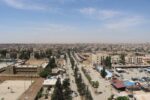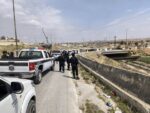
Lawrence Barley
From the Jewish market, to the vertically intersecting streets of the French, and the mosaics of embracing peoples of Armenians, Syriacs, Kurds and Arabs, Qamishlo still writes in the pages of history the words of proof of existence and uniqueness, with love and purity.
On the banks of the Jagjag River, in a land that was once nothing but a wild reed swamp, the city of Qamishlo was born about a hundred years ago. Founded by the French in 1925 as a haven for survivors of massacres and unrest, it sparked life on its straight and orderly streets as a new blank slate.
The Jews of Qamishlo… the heart of the old market
In the memory of the city, the ancient market is not mentioned except with it the Jews of Qamishlo; the first to establish an organized market in the heart of the city. Many of them migrated from neighboring villages to settle in this nascent spot, making the market a hub of movement and commerce: shops filled with spices, fabrics, and jewelry, and the sounds of haggling that never ended. Although the days changed and most of them left later, the “Jewish market” remained a living witness to an important page in the history of Qamishlo.
Lesser Paris… Straight streets and organized memory
The French planned Qamishlo according to geometric foundations that made it resemble an architectural painting; straight and parallel streets that meet at right angles, neighborhoods so neatly organized that people called them “Lesser Paris”. By the beginning of the 1970s, the city had expanded eastward towards Al ‘Antariyah, westward towards Al Hilaliyah, and southward towards the airport. Buildings of residential associations that changed the features of construction appeared, so the building moved from low clay to high-rise concrete buildings.
The name of the city… between Beth Zalin, Qamishli and Qamishlo
The city was called “Beth Zalin” in Syriac, meaning “the place of reeds”. In Kurdish, “Qamishlo” is also “the place of reeds”. As for its current name, his novels are numerous:
 It is Syriac and is said to mean “rise and settle”, referring to the settlement of displaced people in it.
It is Syriac and is said to mean “rise and settle”, referring to the settlement of displaced people in it.
 Or from other Syriac passages that mean “the name of God has risen.”
Or from other Syriac passages that mean “the name of God has risen.”
 There is an opinion that it is from the Kurdish and Turkish word “Qamish” in the sense of reeds, in continuation of the old name.
There is an opinion that it is from the Kurdish and Turkish word “Qamish” in the sense of reeds, in continuation of the old name.
Nusaybin and Qamishlo… The Bridge of Spirit and History
The nearby city of Nusaybin /Nusaybin/was not just a neighbor; she was a spiritual and historical sister to Qamishlo. From them came the Syriacs, the Armenians, the Mordelians, and the Mahalists, carrying their languages, dialects, tales, and the sounds of church bells. The movement of people between the two cities remained alive; it was as if the Jaggag River itself connected two beating hearts.
The mosaic of humans… the mystery of the beauty of the city
In Qamishlo, the street cannot be separated from its people. Armenians and Syriacs built churches and decorated houses with handicrafts. The Kurds came from northern Kurdistan and the neighboring villages of Qamishlo, carrying their music, dialect and culture with all its richness. The Arabs came from the desert and the countryside and established their neighborhoods and markets. Mardaliya and Mahallama, coming from Mardin and the countryside of Nusaybin, added a special flavor and dialects that distinguished them.
Amidst this mosaic, the Jews were an intrinsic part: merchants, neighbors, and shopkeepers in the market that remained the heart of the city.
The Market… Memory and Soul
The old market was not just a place to buy and sell; it was a collective memory. Here the stories of goldsmiths, textile merchants, and spice sellers are told. Even after some of them were demolished and rebuilt, the smell of history remained in the narrow alleys, and the tales of traders who came from Nusaybin, Mardin, Aleppo, Mosul, and Baghdad.
The Unbreakable City
Despite the conflicts, displacement and wars in Syria, Qamishlo remained an open-hearted city. In the years of the revolution, tens of thousands of displaced people resorted to it, and the People’s Protection Units (YPG), the Women’s Protection Units (YPG), and then the Syrian Democratic Forces (SDF) emerged to give the city security and However, Qamishlo kept growing; Imran, humans, and a dream.
The city of reeds, which has become a tale
A century after it was born from the Jagicag reed, Qamishlo has become a city that is not abbreviated by a map or a street. Today, it is a tale of a thousand faces: Christians who settled in it after the journey, Jews who founded its markets, Kurds who built its neighborhoods, Arabs who planted its trees, and Mardaliya and Mahalia who preserved its dialects.
A city that tells us: The wounds of history can blossom life, and the displaced can build a homeland of stone, stories, and songs in various languages.
Ronahi Newspaper
The article appearedA human mosaic from the spirit of Al-Jaqjag reed “in the centenary of Qamishlo”First onKurd Online.
Note: This is a machine translation of the original text in Arabic.اقرأ المزيد



